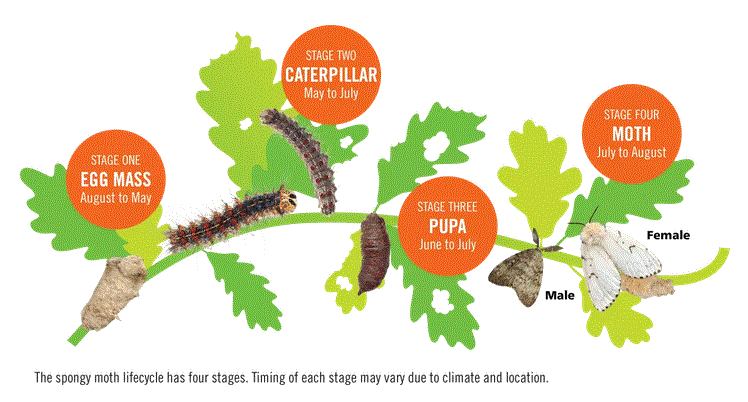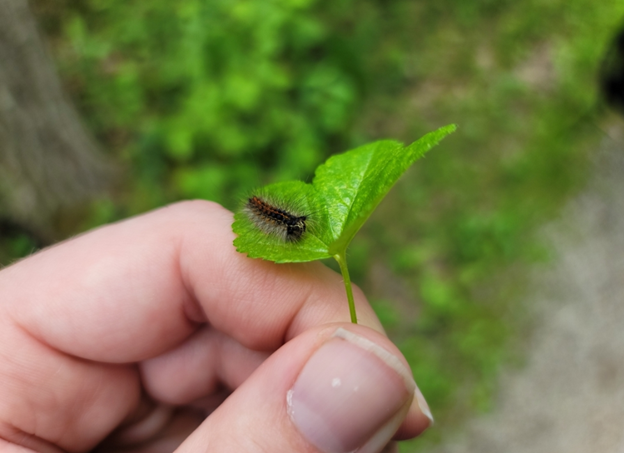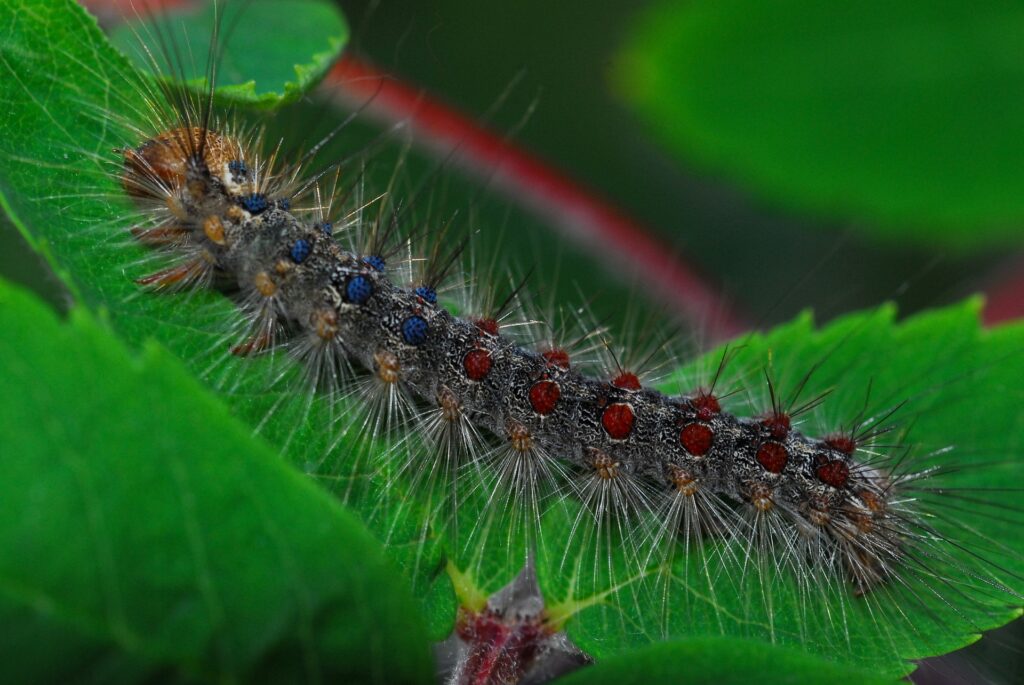Spongy Moth
(Lymantria dispar dispar)
What is it?
The Spongy Moth is an insect species that was introduced to North America from Europe in the late 1800s. We are currently experiencing an outbreak of this species throughout Southern Ontario.
Why is it a problem?
Perception, Experience and Perspective
- In general, we are not overly concerned about the effects that the Spongy Moth is having on our natural forests.
- Healthy deciduous (leaf-bearing) trees are resilient and can survive being completely defoliated, even when this happens several years in a row.
- Long-term damage from the defoliation of a tree is unusual.
- Although there are direct actions you can take, the Spongy Moth population will crash with or without those efforts.
From Invasive to Naturalized
When the Spongy Moth was first introduced, it was considered invasive. Invasive species can devastate ecosystems. The Spongy Moth is considered naturalized at this point, meaning naturally occurring forces take care of larger outbreaks. This means that even without human intervention, this current outbreak will decline. As outlined in the chart below, Spongy moth population decline has historically been as sharp as the population rise. Cycles occur every seven to 10 years and outbreaks last from three to five years.
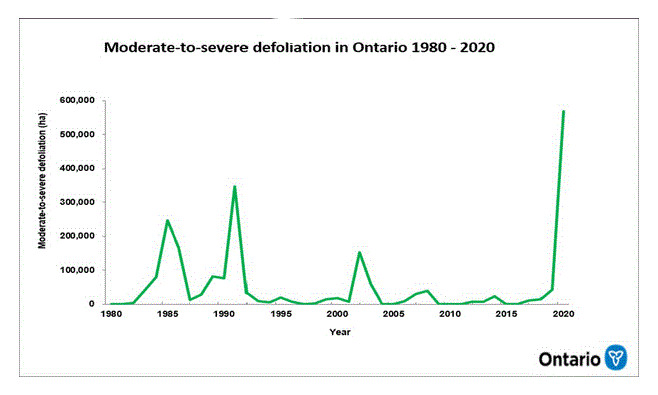
The Bad News
- When trees lose their leaves, they’re more easily stressed and may be more susceptible to other diseases or events such as drought.
- Trees that are already weakened are susceptible to dying, especially with repeated defoliation events.
- Coniferous (evergreen trees) are most susceptible; once they lose their needles, their ability to regrow them is limited. Fortunately, evergreens are not the Spongy Moth’s preferred diet.
The Good News
- A healthy deciduous (leaf-bearing) tree will grow new leaves within the same season.
- Several factors together keep the Spongy Moth in check:
- The nuclear polyhedrosis virus (NPV), which is lethal to the caterpillar
- A fungus, Entomophaga maimaiga, that overwinters in soil and infects the moths, resulting in their death
- Prolonged extreme cold (below negative 26 degrees Celsius in the winter for more than 2 days) coupled with a lack of snow can kill the eggs
- Natural predators including other insects like parasitic wasps, birds like the Black-billed cuckoo and even the white-footed mouse have adapted to eating them in their various life stages
- All of the above combined with starvation due to a lack of food and competition limits the outbreaks from occurring for more than a few years at a time
Identifying the Spongy Moth
The caterpillar is dark and covered with hair that can cause rashes if touched – which is why we always recommend wearing gloves when dealing with the insect, even with the egg masses.
When it’s first hatched from the spongy egg sac, the caterpillar is only millimeters long and is black. It molts 3 – 4 times, growing larger and more distinctive each time.
The female moth is white with brown spots and is flightless. The tan spongy looking sac below her in the photo is an egg mass.
Be aware that a number of look-a-like caterpillars emerge around the same time, including two of our native species: the Eastern Tent Caterpillar and the Forest Tent Caterpillar.
How can I save my trees?
Healthy leaf-bearing deciduous trees can survive the defoliation of a typical Spongy Moth outbreak, even for a few years in a row. Trees of particular concern can be managed individually using the methods below. If your trees are in urban or suburban settings, watering them during times of drought is an important way to help them.
Coniferous trees (evergreens) can be managed by egg scraping and the burlap banding methods below. For larger landowners, the option of using an organic pesticide called Bacillus thuringiensis (BTK) is one management method. Because it will kill all caterpillars, its use needs to be done carefully.
Your best defense against any one pest or disease is a diverse and healthy forest to begin with. We recommend reaching out to a certified forest manager for site-specific evaluations and recommendations.
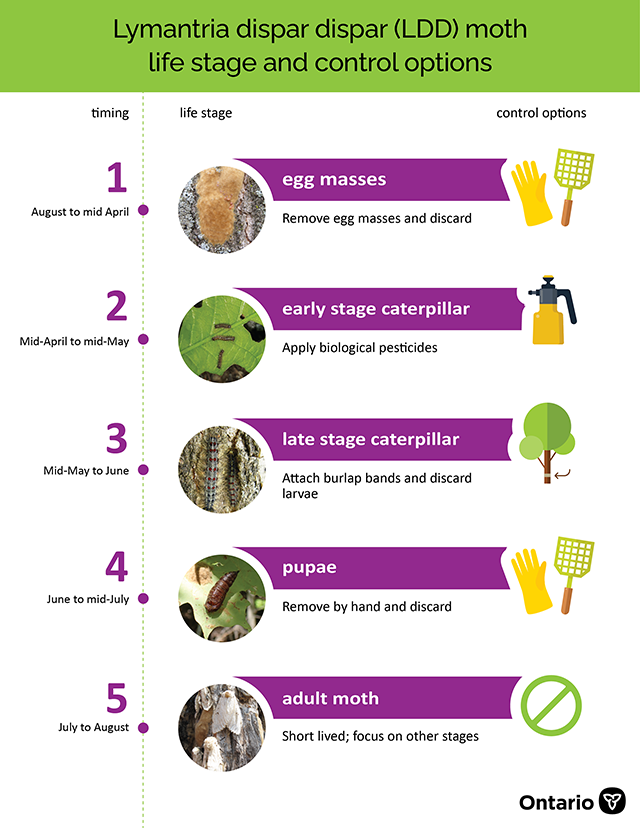
August through to May - Egg Mass Scraping
Removing egg masses from trees and any other immovable object that you might find them on. It’s the easiest way to target the most numbers as one egg mass can contain up to 1,000 potential caterpillars. Egg masses should be scraped into a container of soap and water (no need for anything else), as seen in this video, and left to sit in the water for at least 48 hours before being discarded. Be sure to wear gloves as any contact with even the eggs can result in allergic reactions.
May to July - Burlap Banding
Note this method requires daily monitoring and cleaning.
Once the caterpillar has hatched from the nest, it starts climbing up and eating leaves. The Spongy Moth prefers oak trees but will eat the leaves from most any deciduous (leaf bearing) tree. Burlap banding is the best way to capture the most caterpillars as they move up and down trees to get out of the hot sun.
Burlap banding requires placing a large piece of burlap around the entire circumference of the tree, at about waist height, then tying it off with some string or rope in the middle, and then folding the top of the band over the bottom as seen in this video demonstration. This creates a shelter that will capture the caterpillars as they go down the tree during the day to escape the heat and predators and then again climb up to feed. You need to check and empty these burlap bands daily, scraping them into a bucket of warm soapy water for a few days, covered with a lid so they can’t get out. Simply scraping them to the ground will not kill them.
Time dependent on egg hatching
Spraying an organic pesticide called BTK is possible but requires careful understanding of caterpillar life stages and timing. As it is a non-specific pesticide, meaning it will kill all caterpillars that ingest the leaves it’s sprayed on, even helpful species, we urge extreme caution and avoidance if possible. This option should only be used by skilled professionals who understand life cycles and the small window of opportunity to have an impact with minimal effect on other species.
Not recommended
Using any sort of sticky tape tied around trees. This can inadvertently capture other species including birds, small mammals and snakes.
Not to scare you but there are many worse invasive species...
There are other diseases and pests that are more difficult to manage and have already seriously impacted our forests – like Emerald Ash Borer, Hemlock Wooly Adelgid and Brown Spruce Longhorn Beetle to name a few.
There are a number of new invasives species like the Spotted Lantern Fly and new diseases such as Oak Wilt to be concerned about.
What are we doing?
Science
As a conservation agency, we have a role to play in understanding the science. Together with other conservation authorities, government agencies and municipalities, we collaborate to learn as much as we can and have participated in direct monitoring.
Outreach
We have a teaching role about the underlying ecology, forest health and management options. Understanding the species and impacts is key in making the best decisions. We promote accurate, science-based information through the media and social media, and support our municipal and provincial partners.
Land Managers
As one of the largest landowners in Ontario, conservation authorities need to manage our own trees and forests. That means, like many residents, we evaluate and take action when needed to reduce overly negative impacts. While it’s comforting to know we aren’t overly concerned about the impact of Spongy Moth, at the same time there are many other risks to our trees and woodlots that do garner our attention.
We Help Grow Forests!
We offer funding and expertise to landowners who want to grow or expand existing forests in the Lake Simcoe watershed. New woodlots, windbreaks, streamside plantings are all projects we not only encourage, but support with grant funding. We’ll cover as high as 90% of project costs in some cases. Check out our restoration funding program for more details.
Spongy Moth is Food for Birds
Footnote:
* The Spongy Moth was originally called the European Gypsy Moth but the name was recently removed from the list of commonly accepted names because of it is a derogatory slur often used to describe the Romani people. Its scientific name is Lymantria dispar dispar.
Spongy Moth, Lymantria dispar dispar (LDD) and European Gypsy Moth refer to the same insect. While all our public communications use Spongy Moth, at times we link to some materials not created by us where you may see Lymantria dispar dispar (LDD) or European Gypsy Moth used.

Webinar
Watch the recorded webinar held recently looking towards the 2022 outbreak.
Local Support for Spongy Moth Management
Your local municipality may be supporting some personal management options:

